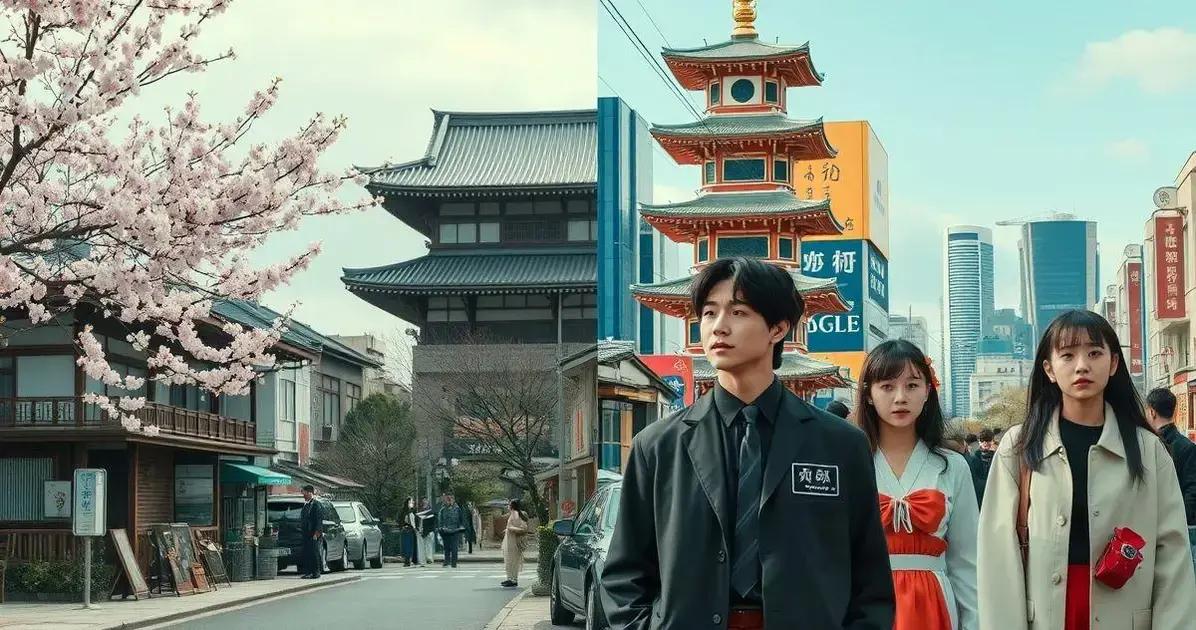Global Popularity of K-dramas vs J-dramas: Which Reigns Supreme?
Anúncios
K-dramas and J-dramas are cultural powerhouses with global appeal, each offering unique storytelling that captivates audiences. K-dramas entice with emotional depth and polished visuals, influencing fashion and beauty trends, while J-dramas provide relatable narratives that delve into societal themes, all enriching global popular culture with distinctive Asian flair.
The **Global Popularity of K-dramas vs J-dramas** highlights an intriguing cultural wave sweeping across entertainment platforms. With a curl of curiosity around how these sensational Asian dramas enchant audiences worldwide, capturing the nuances and essence of both can showcase their unique storytelling spices. As more streaming services continue to feature diverse Asian content, understanding their **impact on global pop culture** becomes imperative for entertainment enthusiasts and cultural commentators.
Exploring the Global Popularity of K-dramas
The global reach of K-dramas has surged, captivating audiences far beyond South Korea’s borders. Their strong emotional storytelling, combined with vibrant visuals and catchy soundtracks, makes a compelling case for their widespread allure. Streaming platforms like Netflix and Viki have played a substantial role in making these dramas accessible worldwide, introducing viewers to a plethora of South Korean talent and captivating narratives.
Key Elements of K-drama Popularity
K-dramas often focus on universal themes like love, family, and perseverance, making them relatable to a global audience. The incorporation of cultural intricacies offers a unique viewing experience, blending modern narratives with traditional values. Furthermore, the format—usually limited series with concise storytelling—ensures that viewers remain engaged without long-term commitments.
Influence of K-pop and Collaborations
A significant factor contributing to the K-drama boom is the synergy with the burgeoning K-pop industry. Many dramas feature popular idols, drawing their fanbase into the mix and generating cross-industry interest. Collaborations like OSTs sung by famous bands or idols amplify dramas’ reach and deepen the emotional connection for the audience.
Additionally, the rich cultural backdrops provide insight into Korean society, enhancing cultural exchange and curiosity among international viewers. This interest often translates into increased tourism, with fans eager to explore filming locations and experience Korean culture firsthand.
Expanding Genres and Innovation
The versatility of K-dramas in venturing into various genres—from thriller and sci-fi to historical and romance—has broadened their appeal. Experimentation with plots and genres keeps content fresh and exciting, ensuring that there’s something for everyone. With ongoing innovations in storytelling and production quality, K-dramas are poised to maintain their stronghold in global entertainment.
J-dramas: A Cultural Phenomenon Worth Watching

Japanese dramas, or J-dramas, hold a distinctive place in the world of television, captivating audiences with their unique storytelling and rich cultural backdrop. Unlike other dramas, J-dramas often focus on everyday life, presenting relatable characters and situations that echo the subtleties of modern Japanese society.
Characteristics of J-dramas
J-dramas are known for their concise storytelling, often wrapped up in 10 to 12 episodes per series. This brevity ensures each episode is packed with meaningful content, avoiding unnecessary filler. They frequently explore social themes, providing thought-provoking narratives that encourage viewers to reflect on their own lives and societal norms.
Genres and Appeal
The diversity of genres in J-dramas ranges from romantic comedies to mystery thrillers and heartfelt family tales. This variety caters to a wide range of tastes, ensuring that whether you are seeking humor, drama, or intrigue, J-dramas have something to offer. Romantic comedies are particularly popular, characterized by their quirky charm and unique storylines.
Many J-dramas are adaptations of popular manga or novels, bringing beloved stories to life with live-action portrayals. This gives fans of these mediums added appeal, encouraging cross-genre exploration.
Influence of J-pop Culture
J-dramas often feature J-pop artists in prominent roles or as part of the musical scores, blending the music and television industries. This crossover not only enhances the viewer’s experience but also boosts the dramas’ popularity, drawing fans from the music industry to explore new shows.
The distinct Japanese aesthetic, melded with universal storylines, makes J-dramas a powerful cultural export. Their ability to engage international audiences while offering a glimpse into Japanese culture contributes significantly to their standing as a cultural phenomenon worth exploring.
K-dramas vs J-dramas: Key Differences in Appeal
The comparison between K-dramas and J-dramas reveals intriguing differences in storytelling styles and viewer appeal. Both forms of entertainment hold distinctive characteristics that cater to diverse audiences. Understanding these differences can enhance your viewing experience.
Narrative Style
K-dramas often feature highly dramatic and emotionally charged storylines, enhanced by polished production values and intricate plots. These dramas are known for their romantic arcs and cliffhanger endings that keep viewers eagerly coming back for more. In contrast, J-dramas tend to be more subtle and often reflect everyday life. They focus on slice-of-life stories with a realistic approach, frequently addressing social issues in an approachable manner.
Character Development
In K-dramas, characters are often larger-than-life with intense emotional arcs. Viewers are drawn in by their deep, personal journeys. J-dramas, however, typically present more relatable characters with whom viewers can easily identify. The emphasis is on character depth and gradual development, appealing to those who enjoy watching characters evolve over time.
Cultural Context
South Korean culture is prominently featured in K-dramas, often showcasing the country’s modern fashion, music, and societal trends. This cultural showcase makes K-dramas an immersive experience for audiences worldwide. Meanwhile, J-dramas offer a window into Japanese traditions and lifestyle, focusing on local customs, mannerisms, and everyday interactions. This cultural insight is both educational and entertaining for international viewers.
Each of these entertainment forms brings its own unique flavor to the screen, making both K-dramas and J-dramas incredibly appealing to a broad spectrum of audiences. Whether you seek vibrant emotions or subtle realism, the appeal of these dramas is undeniable.
Impact of K-dramas and J-dramas on Global Pop Culture

The influence of K-dramas and J-dramas on global pop culture is profound and far-reaching. These dramas have not only captured audiences worldwide but also inspired a new wave of interest in Asian cultures, and their impact is visible in several areas of entertainment and lifestyle.
Fashion and Beauty Trends
K-dramas have had a significant impact on global fashion, popularizing Korean beauty products and styles. The fashion choices of drama characters often become trends, with fans aiming to emulate the chic and polished looks. In contrast, J-dramas frequently introduce unique fashion statements that highlight Japan’s eclectic style. This cross-cultural fashion exchange enriches the global style scene, offering a diverse palette of inspiration.
Food and Cuisine
The culinary delights often featured in these dramas have tempted international audiences to explore Asian cuisine. K-dramas frequently showcase Korean dishes like kimchi and bulgogi, fostering a craving for Korean food worldwide. Similarly, J-dramas highlight Japanese dishes like sushi and ramen, encouraging viewers to delve into Japanese culinary art. This cultural exposure acts as a bridge, bringing people together through food.
Language and Learning
Increased interest in these dramas has also sparked demand for learning Korean and Japanese languages. Fans eager to understand their favorite dramas better or sing along with soundtracks often embark on language-learning journeys. This trend supports cultural appreciation and understanding, connecting global communities through shared interests.
The burgeoning influence of K-dramas and J-dramas on pop culture illustrates their ability to transcend boundaries, enriching global entertainment with their unique storytelling and vibrant cultural elements.
Summarizing the Global Popularity of K-dramas vs J-dramas
The profound impact of K-dramas and J-dramas on global culture highlights their importance as powerful cultural exports. Each offers unique storytelling styles that broaden entertainment horizons.
K-dramas excel in emotional storytelling with vibrant visuals, while J-dramas provide subtle narratives set against the backdrop of everyday life. Both formats have spread their influence far and wide, shaping trends in fashion, cuisine, and language learning.
The universality and cultural richness embedded within these dramas have garnered devoted fanbases across the world, each eager to connect with and participate in diverse cultures. As they continue to break international barriers, K-dramas and J-dramas reinforce their role as pivotal players in the global entertainment arena.
The exploration of these dramas not only entertains but enriches global audiences, allowing a deeper appreciation of Asian cultures and storytelling traditions. The supreme reign of K-dramas and J-dramas is set to persist, captivating hearts and minds globally.
FAQ – Frequently Asked Questions about K-dramas and J-dramas
What makes K-dramas so popular globally?
K-dramas are popular for their emotional storytelling, high production quality, and relatable themes like love and family, engaging a diverse audience.
How do J-dramas differ from K-dramas?
J-dramas focus on everyday life with subtle storytelling and realistic characters, often addressing social issues, which contrasts with the intense narratives of K-dramas.
What cultural elements do K-dramas and J-dramas showcase?
K-dramas highlight South Korean fashion, music, and social trends, while J-dramas offer insights into Japanese customs, traditions, and lifestyle.
How have K-dramas and J-dramas impacted global fashion and cuisine?
K-dramas have popularized Korean beauty products and fashion, while J-dramas highlight unique Japanese styles. Both have increased global interest in Korean and Japanese cuisine.
Why are people interested in learning Korean and Japanese due to these dramas?
The popularity of these dramas inspires fans to learn the languages for a deeper understanding of the content and to engage more with the culture.







